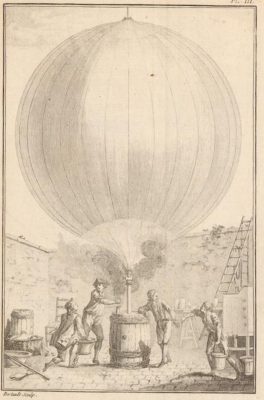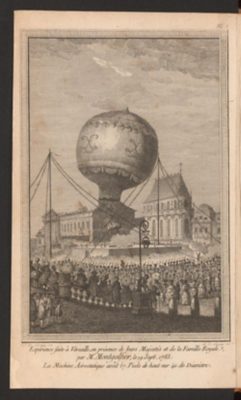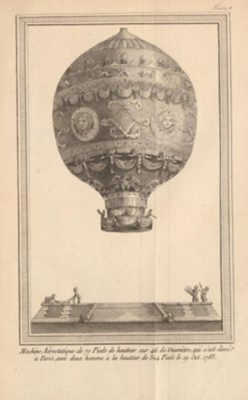This new and exciting acquisition takes our collection on the history of technology to new heights! Enclosed in the two discreet volumes are first editions of the earliest-published scientific treatise on the pioneering exploits of the Montgolfier brothers, whose hot air balloons are generally acknowledged as the first successful free-flying apparatus in history.
The story, as it goes, begins with a moment comparable to the tale of Newton's realization of the principles of gravity after observing an apple fall from a tree. In November 1782, Joseph-Michel Montgolfier claimed to have been sitting out in a courtyard contemplating how to overcome gravity. All at once, he observed sheets billow, form a pocket and rise up into the air while drying on a washing line next to a fire. Thinking that this was due to a special gas in the smoke, rather than the heat, he made a device topped with a taffeta cloth sack to capture the smoke and exploit its lifting qualities. His experiment was a success and excitedly he wrote to his brother, Jacques-Étienne, requesting that he acquire more taffeta for a larger prototype of what he described as "one of the most astonishing sights in the world."
The author, Barthélemy Faujas de Saint-Fond, is not unknown to the collection of the Iron Library. An outstanding and well-connected natural scientist, he published works on geology, mineralogy and volcanology, as well as a famous travelogue of his journey around Scotland (Iron Library Catalog Signature: EM/Rb 569). Impressed upon hearing a report of the unpiloted test of the Montgolfiers' larger prototype – "a cloud enclosed in a sack" – at Annonay in June 1783, he contacted the brothers and became their patron, financier and – as these volumes attest – chronicler.
With his connections, and on a wave of public interest spreading through the Kingdom of France, the first piloted free flying balloon demonstration was organized to be held at Versailles before King Louis XVI and Queen Marie Antoinette in September 1783. The 'pilots' were not the Montgolfier brothers, however, nor were they the condemned convicts that the king had suggested, but three animals: a sheep, a rooster and a duck! This may seem a rather eccentric decision, however for the period it was considered a highly appropriate and scientific approach. At the time, nobody knew how a human body might respond to the upper atmosphere. The sheep was chosen as it was thought to approximate a human in physical qualities. The duck was selected as a common robust bird capable of flight and the rooster as a bird incapable of flight but a bird nonetheless – as a sort of control!
The flight lasted 8 minutes, flew three kilometers and ascended to an estimated 460 meters. The survival of the three animals prepared the way for the first human-piloted free flight. At a demonstration at the Bois de Boulogne on 21st November 1783, almost a year to the day after Joseph-Michel's realization, courtiers Jean-François Pilâtre de Rozier and François Laurent le Vieux d'Arlandes became the first people to fly in recorded history.
Faujas de Saint-Fond's two volumes are rich in detail. They combine technical reviews of the balloons, descriptions and analyses of the early flights, reports of different observer perspectives and details of other theories for lighter than air flight. The engravings, meanwhile, are amongst the most recognizable and iconic in the history of enlightenment technology. Together, they bring an added historical depth to the Iron Library's holdings on the history of flight technology, a large part of which has been acquired to date through closely following the work of GF Casting Solutions and GF Machining solutions, for whom aircraft components are an area of competence.





